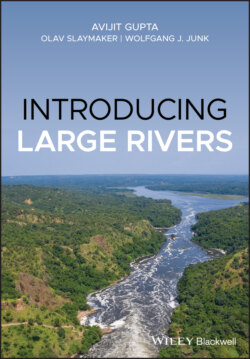Читать книгу Introducing Large Rivers - Avijit Gupta - Страница 15
2.2 The Geological Framework: Elevated Land and a Large Catchment
ОглавлениеMany of the existing large rivers start at an elevated orogenic zone, drain a subcontinental-scale area, and flow to the ocean through a major delta. The orogeny is usually created by convergence of two tectonic plates. The course of the river may be determined by a large-scale geofracture which it follows, and its mouth may be positioned by a rock basin at the trailing margin of one of the plates. The Amazon is an excellent example. Another example is that of the present Lower Mississippi, still located over a Cretaceous sub-surface rock embayment near its present confluence with the Ohio. It has been suggested that this embayment underneath the sediment of the river is related to a reactivated rift whose history may have started much earlier in the late Precambrian (Ervin and McGinnis 1975; Potter 1978; Knox 2007).
An uplifted zone, often formed by plate collisions, and an adjoining uplifted sub-continental-scale catchment area are the necessary requirements for a major river (Tandon and Sinha 2007). These conditions exist for a time long enough to create and sustain the river system. The present continental land masses are large enough to support the current big rivers, but the size of the land masses has not always been the same. An existing drainage can be modified over time due to changes in tectonic, geomorphic, and hydrologic systems. Rivers larger than those of the present time probably existed during the supercontinents of the Wilson cycle (Pangea and Rhodinia). In contrast, very early rivers on Earth probably did not become large due to limited hydrologic support and restricted basin area on land (Potter 1978). Tectonic movements and the following geomorphic processes determine the required development of the basin topography marked by elevated boundaries and a regional slope. Continental plate tectonics determine the basin framework and trough of the river, and regional disruptions vary its character, locally.
On fewer occasions, a new topography and a confined river is created by rifting, as shown by the Rio Grande, which is a pull-apart system that began in the early Miocene and developed from separate shallow basins to an integrated system. The failed arm at a plate tectonics triple junction also may give rise to rifting which may carry a big river that occupies the long, narrow, deeply filled depression extending into a craton. At the other end of the linear depression, the river builds a delta at the plate boundary marking the edge of the continent. The Niger is an example. Another example is the Blue Nile which rises within the rift system of Ethiopia to flow through a deep gorge for about half of its length.
A new topography and a modified river may also be formed off a mantle plume (Cox 1989) when it rises to create an extensive domal surface with high elevation, as happened in several parts of the Earth during the Late Cretaceous. Certain areas were uplifted by doming and magmatic underplating, giving rise to topographic highs and new drainage systems. The Orange and part of the Zambezi River are examples.
Not all large rivers fall into such clearly generalised classes. Some do not rise from currently active orogenic belts but drain parts of old mountains that have some elevation or are only slightly active tectonically. Tandon and Sinha (2007) described such rivers as located in cratonic settings as these drain major cratons. Examples of this type are the Mississippi, Yukon, Yenisei, Lena, and Ob. Potter (1978) stated that four major morphological patterns may cover the majority of large rivers. These can be described as:
1 (1) Most sediment derived from mountains marginal to a large craton (the Amazon).
2 (2) The river flowing marginal and parallel to a fold belt (the Ganga).
3 (3) A big river flowing along the strike of a mountain range (the Mekong).
4 (4) A river superimposed across multiple mountain chains (the Danube).
Potter proposed a fifth possibility which may have occurred in the past: a river on a large craton without bordering mountains (Potter 1978).
